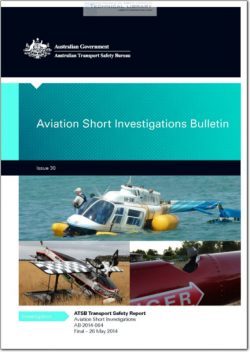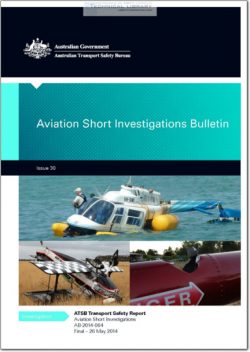ATSB-AB-2014-064

- Version
- 155 Downloads
- 4.43 MB File Size
- 1 File Count
- August 8, 2016 Create Date
- August 8, 2016 Last Updated
Aviation Short Investigation Bulletin - Issue 30

Soon after 0600 Eastern Daylight-saving Time1 on 4 January 2013, a Boeing 737-800, registered
VH-VUZ, departed Launceston, Tasmania for Melbourne, Victoria. The flight was a scheduled
passenger service, with a planned flight time of 48 minutes. The first officer (F0) was the pilot
flying (PF).
During the departure, as the aircraft climbed through about 3,900 ft, the FO selected level change
(LVL CHG) as the vertical auto-flight mode and an airspeed of 250 kt, with the intention of later
selecting vertical navigation (VNAV) mode. During the investigation, both crew commented that
VNAV mode is normally selected to manage aircraft airspeed and vertical profile during departure,
but on this occasion the FO elected to use LVL CHG mode. The F0 could not recall why
LVL CHG mode was used on this occasion, but the captain recalled that it was probably used to
expedite climb through a layer of cloud and/or turbulence. Both crew members overlooked the
intended subsequent selection of VNAV mode, so the aircraft continued to climb in LVL CHG
mode at a constant 250 kt. The characteristics of each relevant vertical auto-flight mode are
outlined later in the report.
As the aircraft climbed at a constant airspeed, the aircraft Mach number2 was steadily increasing.
Passing about flight level (FL)3 260, the auto-flight system sequenced automatically from climb at
a constant airspeed of 250 kt, to climb at a constant Mach 0.62, which was the Mach number
corresponding to 250 kt at the point that the changeover occurred. As the aircraft then continued
to climb at a constant Mach 0.62, the airspeed slowly reduced.4 The changeover from a constant
airspeed to a constant Mach number during the climb went unnoticed by the crew, as did the
gradually reducing airspeed as climb continued beyond the changeover altitude.
Approaching FL 350, about 20 minutes after departure, the FO noticed a ‘buffet alert’ caution
appear in the scratchpad of the control display unit (CDU).5 At about the same time, the captain
recalled that the aircraft auto-flight system made a small but noticeable pitch attitude reduction.
Both pilots immediately directed their attention to the primary flight display and noticed that
airspeed had reduced to the point that it was near the top of the amber bar on the airspeed
indicator. The top of the amber bar represents the aircraft minimum manoeuvre airspeed
(described in detail later in the report).
| File | Action |
|---|---|
| ATSB-AB-2014-064 Aviation Short Investigation Bulletin - Issue 30.pdf | Download |

Comment On This Post